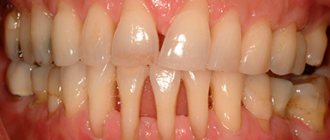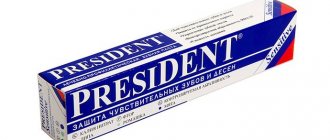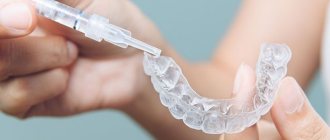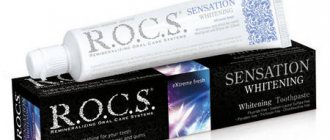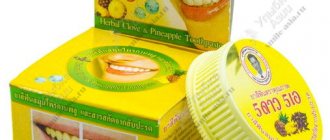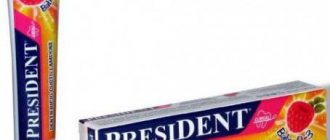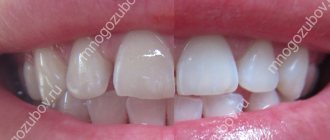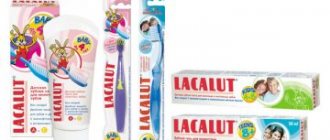Periodontal disease and periodontitis are very easy to detect - the periodontal soft tissues are instantly affected, begin to itch and bleed. If these diseases are not treated in time and you do not carefully monitor oral hygiene, then the teeth will subsequently begin to move and fall out.
| Place | Name | Characteristics in the rating |
| The best whitening pastes for periodontal disease |
| 1 | Apadent filling | Best quality. Allowed at any age |
| 2 | Swissden Extreme | Whitens gently. Fights diseases |
| 3 | Jason Natural | Prevents the formation of tartar |
| 4 | Asepta Sensitive | Best price. Good composition |
| 5 | Dr. Theiss Lakalut Fluorine | Contains fluoride and aluminum lactate |
| The best anti-inflammatory pastes for periodontitis |
| 1 | SATO Access | Better efficiency. Fast treatment |
| 2 | BioRepair Protezione Gengive | Instantly restores gum tissue |
| 3 | Vitex Dentavit Sensitive | Suitable for almost everyone. Gently cleanses |
| 4 | Patanjali Dant Canti Advanced | Natural ingredients. Ayurvedic |
| 5 | Splat Medicinal herbs | Professional effect for little money |
After visiting the dentist, you should take a closer look at your toothpaste. If the spectrum of its effects does not include medicinal components, it needs to be replaced. Below we will tell you exactly which pastes treat dental diseases and how each of them differs. Our rating of the best toothpastes for periodontitis and periodontal disease will help you effectively overcome ailments and maintain the good condition of your teeth for a long time.
BENEFITS OF FLUORIDE COMPOUNDS IN TOOTH PASTES
It has been scientifically proven that fluoride compounds have an anti-caries effect, and this substance also affects the functioning of the entire body.
Benefits of fluoride:
- Fluoride strengthens tooth enamel. The composition of tooth enamel includes calcium hydroxyapatite, active fluoride ions interact with it to form fluorapatite. This compound is more resistant to the influence of waste products of cariogenic microorganisms.
- Fluoride is a natural antiseptic. Its compounds have an antibacterial effect
- Prevents the formation of dental plaque.
- Increases the remineralizing effect of saliva . Fluoride has a positive effect on the functioning of the salivary glands, significantly accelerating the production of saliva. Phosphorus and calcium ions contained in saliva penetrate the tooth enamel and prevent the development of caries.
- Fluorine is involved in metabolic processes. Microscopic doses of fluoride have a beneficial effect on metabolism and the general condition of the body. Scientists have proven that dosed consumption of fluoride during pregnancy helps to reduce the depth of natural depressions (fissures) on the surface of the teeth of the unborn child, which are the predominant zone of caries localization.
However, despite all the positive effects, before using fluoridated toothpaste, you must consult a doctor, find out the level of fluoride in the water and strictly adhere to all the specialist’s recommendations. Do not forget that fluoridation is one of the methods for preventing caries, which must be used with caution.
Rating of popular pastes containing fluoride
Modern pharmacies offer customers a wide range of dental care products. Below we consider a short list of the most common fluoride-containing pastes that are in demand among buyers:
- Paradontax for healthy teeth and gums. Restores damaged gums, reduces bleeding. The fluoride present in the composition actively fights the formation of plaque and effectively removes it. Also, this product, according to the manufacturer, is an excellent prevention of caries development. In the list of the best fluoride toothpastes, this product occupies a leading position.
- Colgate for protection against caries is an inexpensive product, one of the most popular in the country, which can be bought at any pharmacy or supermarket. Effectively maintains cleanliness and health of the oral cavity, fights the appearance of tartar.
- Blend-a-med with active fluoride. Users appreciate this product for its price-quality ratio. Pasta can be bought at a very affordable price. The product does a good job of removing plaque and bad breath. But even daily use of such a product will not help make your smile snow-white, but it will successfully deal with bacteria and soft deposits.
- Sensodyne against hypersensitivity of teeth. For patients with increased tooth sensitivity, this product will be an effective remedy. The paste does a good job of preventing caries. But constant use is not advisable.
If you brush your teeth correctly with a well-chosen fluoride toothpaste, you can avoid the development of diseases. To regularly clean the enamel, it is recommended to use the products recommended by the dentist. If necessary, the doctor will tell you how to properly brush your teeth, how to use mouthwash and dental floss. In case of inflammatory processes and bleeding gums, special remedies will be required. Also remember to visit your dentist twice a year.
HARM OF FLUORIDE TO THE HUMAN BODY
Excess fluoride in the human body can lead to the development of many negative reactions from various systems.
- Fluoride has a neurotoxic effect , especially pronounced in young children. Its excess can cause impaired speech abilities, significantly reduce the ability to learn foreign languages, mathematics, and affect memory.
- One of the reasons for changes in hormonal levels is the high fluoride content in consumed foods, water and hygiene products. Fluoride ions accumulate in the tissues of the thyroid gland, which disrupts the synthesis of thyroid hormones and reduces testosterone levels, which can cause the development of many abnormalities, including infertility.
- An excess of fluoride is the only reason for the development of fluorosis , which has two forms of manifestation:
- on the part of the dental system, the disease is manifested by the development of so-called spotted tooth enamel;
- Bone tissue affected by fluorosis becomes fragile as a result of excessive mineralization and an imbalance between organic and inorganic compounds; such pathology increases the risk of fractures and increases joint mobility.
4. Some scientists adhere to the theory that in high concentrations, fluoride ions are carcinogenic.
When choosing products for oral hygiene, in particular toothpastes with fluoride, do not forget that every day a certain amount of this substance enters the body from fluoridated water; food products prepared on it; vegetables and fruits. In regions with high levels of fluoride in water, the use of fluoride toothpastes for caries prevention is not recommended.
Substance poisoning - symptoms
A sufficient, but not excessive intake of this substance into the body helps strengthen the enamel and improve the condition of the teeth. However, overdose can cause serious damage. Usually in such cases they talk about the development of fluorosis. Among the most common varieties of this pathology, experts in the field of dentistry distinguish spotted, streaked, chalky-speckled, erosive and destructive forms. Let's look at them in a little more detail:
- spotted - involves the formation of small light spots on the enamel, which can merge with each other, forming one large spot,
- streaked - light stripes of different shapes appear on the incisors, which can also combine to form fairly large strokes,
- chalky-mottled - the surface of the teeth becomes dull and yellowish, while many dots and specks appear on its surface. Pathological abrasion of the enamel is noted, due to which the dark color of dentin begins to appear,
- erosive – leads to the formation of numerous specks, but primarily affects the chewing surface of the teeth,
- destructive – dental tissues become fragile and quickly break down.
The photo shows dental fluorosis.
An excess of fluoride in the body also affects the condition of the skeletal system. One possible complication is osteoporosis, in which the bones become soft and calcium is quickly washed out of them. Pathological changes occur in the joints, causing ankylosis to develop. In advanced cases, the liver and kidneys suffer.
FLUORIDE COMPOUNDS IN TOOTHPASTES
Toothpaste with fluoride was first released more than 100 years ago (more precisely in 1914) in the USA. However, it was only in the 50s of the last century that such pastes were improved and recognized as useful. Today, fluoride toothpastes are the most common teeth cleaning products.
In its pure form, fluorine is a gaseous substance, so it can only be included in pastes in the form of soluble salts - fluorides. At a temperature of about 37 degrees and contact with saliva, this compound disintegrates and active fluorine ions are released.
The most common fluoride compounds found in toothpastes
Modern toothpastes contain the following fluoride compounds:
- Pastes with sodium monofluorophosphate are ineffective when brushing teeth quickly (less than 3 minutes), since active fluoride ions from this compound are released very slowly.
- Sodium fluoride - quickly dissociates (breaks up) into ions, therefore it has higher efficiency.
- Olaflur (aminofluoride) is one of the latest developments; after using a paste based on it, a film remains on the tooth enamel, releasing fluoride ions for a long time.
- Aluminum fluoride.
- Tin fluoride.
Purpose and features of triclosan
The component was first obtained in 1965 by Swiss scientists. The drug belongs to the chlorophenolic group. It is widely used in hygiene products and household chemicals as an antibacterial substance. After the introduction of this component, many studies were conducted to study its safety in relation to human health.
Due to its antibacterial properties, triclosan is active against a wide range of microorganisms. The effectiveness of its use is confirmed by many years of practical experience in using it in hygiene products. The component interacts well with other components of dental products, which makes it possible to create complex formulations. Even in low concentrations it does not lose its properties.
Triclosan acts on the cytoplasmic membranes of various microorganisms, thereby effectively neutralizing pathogenic fungi and bacteria. A significant disadvantage is the destruction of not only negative, but also beneficial microflora.
HOW TO PROTECT YOUR BODY FROM THE EXPOSURE OF FLUORIDE WHEN BRUSHING YOUR TEETH
To ensure that active fluoride ions do not cause harm to the body, you must adhere to a few simple rules:
- Study the packaging of the toothpaste when purchasing, pay attention to which fluoride compound is included in its composition and in what concentration.
- Before using a fluoridated product, you should consult with a specialist ; perhaps the level of fluoride in the water in the region where you live is sufficient and such a paste will only cause harm.
- Children under 6 years of age should not use fluoridated toothpaste . At this age, children do not fully have the skills to brush their teeth, which can cause them to swallow large amounts of hygiene products.
- When planning a vacation in other regions, you should pay attention to the level of natural fluoride content in drinking water. If the content is normal or high, you should stop using fluoridated toothpastes during the rest period.
- To minimize the amount of fluoride that enters the body when brushing your teeth, the amount of toothpaste should not exceed the size of a small pea.
In addition to pastes, fluoride is included in rinses, special gels and chewing strips, as well as dental preparations that are used in a professional office. Therefore, the choice of a method for preventing the development of caries should be left to the dentist and strictly adhere to all his recommendations.
Source
Selection of pastes
In order for your daily oral hygiene procedure to give maximum results, you need to take the selection of toothpaste seriously. It's better to consult your dentist. There are products on the market that can be divided into three groups:
- Hygienic - presented in a fairly wide range. Their action is aimed at cleansing the enamel and freshening breath.
- Medicinal - can be purchased at any pharmacy. The composition includes active components that can stop or prevent the development of inflammatory processes in the oral cavity.
- Therapeutic and preventive – prevent the active development of caries and other diseases.
Before you buy a paste, you should carefully read its composition. When choosing a product, the buyer must take into account the current condition of his teeth. If difficulties arise, it is better to consult a dentist who will help you choose the appropriate hygiene product.
Composition of products without its content
Fortunately, after a series of studies and awareness of the harm of fluoride-containing pastes, the manufacturer began to create products without this element. Let's look at their composition.
Every fluoride-free toothpaste uses calcium, or more precisely, its compounds. Calcium compounds help demineralize teeth when there is excess fluoride, and also help eliminate it . Most often, such toothpastes are needed by children, since baby teeth are very sensitive and are easily exposed to fluoride compounds.
Triclosan's formidable weapon - ppGpp
Triclosan interferes with antibiotic treatment, but how? Levin and co-authors of the study found that triclosan works with a cell growth inhibitor, the small molecule ppGpp
to make cells less sensitive to antibiotics. During periods of stress, ppGpp reacts by shutting down the biosynthetic pathways that produce the building blocks—DNA, RNA, protein and fat—that eventually become new cells. This response helps divert resources away from growth and survival. If triclosan triggers ppGpp, biosynthesis is reduced and bactericidal antibiotics become ineffective at killing cells. However, biosynthesis continues in bacteria lacking ppGpp, and these cells subsequently die. Levin and co-authors tested their hypothesis by constructing mutated E. coli that were unable to fire ppGpp and compared them with E. coli that were able to fire ppGpp. The absence of ppGpp in mutated E. coli rendered triclosan unable to protect cells from bactericidal antibiotics.
Although clinical studies will be needed to definitively prove that triclosan interferes with antibiotic treatment in humans, Petra Levin said: “I hope this study serves as a warning to help us rethink the importance of antimicrobials in consumer products.”
The authors of another study claim that antibacterial soap may cause cirrhosis of the liver.
.
Sources
- https://www.health.harvard.edu/blog/are-antibacterial-products-with-triclosan-fueling-bacterial-resistance-2019080617473
- Weatherly LM, Gosse JA Triclosan exposure, transformation, and human health effects // J. Toxicol Environ Health B Crit Rev. 2017; 20(8): 447–469. doi: 10.1080/10937404.2017.1399306
- What is triclosan? // Medvyvod.ru. 2014. February 15. URL: https://www.medvyvod.ru/medical_news/3098.html
- Detusheva E.V. Modeling a biofilm in bacteria on a solid nutrient medium and studying the patterns of formation and resistance to triclosan: dissertation. ...cand. biol. Sci. Obolensk, 2016. 158 p.
- Campbell L., Zirwas MJ Triclosan. // Dermatitis. 2006. Vol. 17(4). P. 204-207.
- Shaofang Cai, Jiahao Zhu, Lingling Sun, et al. Association between urinary triclosan with bone mass density and osteoporosis in US adult women, 2005-2010 // J Clin Endocrinol Metab. 2019; 104(10): 4531–4538
- Dhillon GS, Kaur S, Pulicharla R, Brar SK, Cledón M, Verma M, Surampalli RY. Triclosan: current status, occurrence, environmental risks and bioaccumulation potential // Int J Environ Res Public Health. 2015. May 22; 12(5): 5657–5584
- Vosátka R, Krátký M, Vinšová J. Triclosan and its derivatives as antimycobacterial active agents // Eur J Pharm Sci. 2022. Mar 1; Vol. 114. P. 318–331
- Chigrinets S.V., Bryukhin G.V. The impact of endocrine disruptors on the quality of ejaculate in men // Andrology and genital surgery. – 2022. – T. 19. – P. 42–47
- https://www.fda.gov/consumers/consumer-updates/5-things-know-about-triclosan
- The Svoboda factory has resumed production of soap with triclosan // Cosmetic-industry.com. 2022. April 3. URL: https://cosmetic-industry.com/fabrika-svoboda-vypustit-polmilliona-shtuk-myla-s-triklozanom-do-kontsa-mesyatsa.html
Can the presence of triclosan in the body interfere with the treatment of UTIs?
Scientists have found that mice that drink water with triclosan have levels of triclosan in their urine similar to those reported by humans.
"This result meant that we could actually test the effect of human urinary triclosan levels on antibiotics for UTIs in mice,"
- Petra Levin said.
All mice with infection received ciprofloxacin for the treatment of UTI. Only some of the mice drank water with triclosan. After antibiotic treatment, mice exposed to triclosan had large numbers of bacteria in their urine and adhered to the bladder; unexposed mice had significantly lower bacterial counts.
“The magnitude of the difference in bacterial load between mice that drank water with triclosan and those that did not is striking,”
- Levine said.
"If the difference in bacteria counts between groups was less than 10-fold, it would be difficult to conclusively prove that triclosan was the culprit,"
- Levin added.
“We found 100 times more bacteria in the urine of mice treated with triclosan—that’s a lot.”
This striking result leads to the conclusion that antibiotics are less effective in treating UTIs when triclosan is present, at least in mice.
